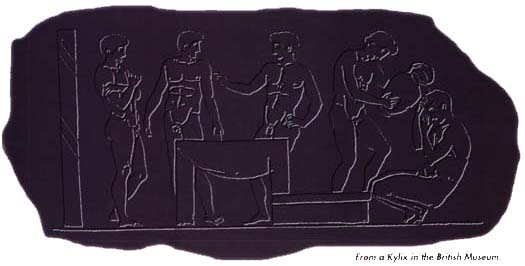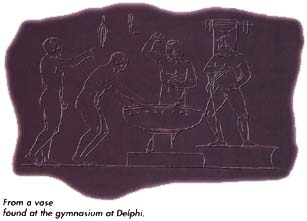courtesy of Plumbing & Mechanical Magazine, July 1996
In Coroehus’ time, the Olympic arena meant little more than an open space in a grove where the ground had been cleared for running or wrestling. With construction costs estimated at $1.8 billion for the 1996 summer games, athletes can look forward to experiencing the best this country and this industry has to offer. Since we’re not allowed to view the gold medal facilities until after the Olympics, PM took a step back in time to fifth-century B.C. Greece and discovered how they plumbed the games.
In his treatise on the Athenian Republic written around 450 B.C., Xenophon writes that there are three essential parts to a competition and training center, “besides the actual runs and wrestling-rings, some place where those who use them may undress and oil themselves before exercise, and may wash themselves afterwards.”
Called the gymnasium and the palaestra, athletes trained and competed in these centers and men of all ages resorted to them for their daily exercise. They also served as learning centers where philosophers such as Plato discussed the fundamentals of life with their pupils in the bench-lined dressing rooms. In these rooms, competitors would unclothe themselves, anoint themselves with oil, then place their belongings in as safe a place as possible. Because the rooms were large and overpopulated, the Greeks found it necessary to enact severe laws against theft. A law attributed to Solon imposed the penalty of death on any one who stole any object, for example a jar of oil, worth more than10 drachmae.
After a day of running, throwing the javelin and discus, jumping and wrestling under the harsh eye of an elder instructor, a youth would take to the bath. While Greece is known for its hot baths and vapor baths, these plunge baths had nothing to do with the gymnasium. To frequent such baths was considered a sign of effeminacy and Plato wrote that they only were suitable for the old and feeble.
Instead, after using a strigile, a highly ornamental iron or bronze and sometimes gold or silver curved scraper to remove dirt and sweat and also remove moisture and lather, after the bath, the athlete would wash in cold water. One form of washing is represented on a black-figured engraving which dates from the close of the sixth century. Hanging their clothes on branches of the trees, a group of young men and boys wash in cold water issued from two panthers’ heads. On either side stand others preparing for their baths by either oiling or powdering themselves. The Greeks used powder, oil and scrapers much more frequently than soap, which was made of goat fat and wood ashes. Excavations have found several of these uncovered washing areas with fountains in the shape of animals’ heads placed so the water falls conveniently over the heads and shoulders of the bathers. Basins catch the water which then falls into large stone troughs that carry the water outside the building and into the ravine.
Another way to wash is represented by the two figures illustrating this story. The washing takes place in a bathroom with a large stone or metal basin placed in the middle. In the figure to the left, the youth on the right pours water into the basin from a bucket he has drawn up from the cistern below. The athlete next to him uses a strigile to remove moisture while another splashes the water over himself. With drains in the floor, often times an assistant would dump the cold water on the youth, for a more satisfactory way of washing.
Later years brought about the inclusion of the hot baths and rows of stone troughs with lion head spouts about 3 feet from the ground where competitors as well as spectators could sit and bathe their feet. What is lacking though, is any mention of the toilet. While many private residences in Greece had latrines that drained into a sewer beneath the street, mention of their presence in the gymnasium or palaestra is scattered. We hope with Atlanta’s billion-dollar investment, that necessary fixture won’t be so hard to find.






